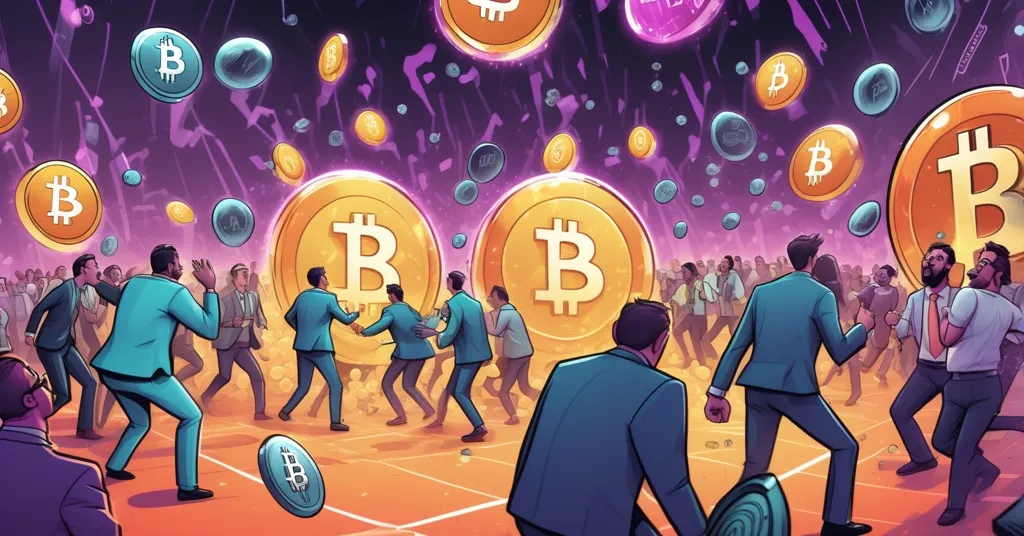Pump.fun Token Crashes Below ICO Price: $600M Hype Bubble Bursts on Solana

Pump.fun Token Plummets Below ICO Price: A $600M Crypto Hype Bubble Bursts
Pump.fun’s PUMP token has nosedived below its ICO price, shattering dreams after a jaw-dropping $600 million raise. This Solana-based meme coin launchpad, once hailed as the next big thing, has become a textbook case of crypto overhype, leaving investors burned and the market questioning the sustainability of speculative frenzy in digital assets.
- Stunning Collapse: PUMP token raised over $600 million but crashed 21% in 24 hours, trading at $0.00406—below its ICO price.
- Mass Exit: Nearly 60% of early investors sold off, per BitMEX data, signaling a collapse of confidence.
- Empty Value: No utility, rewards, or airdrops underpin PUMP, despite listings on major exchanges like OKX and Kraken.
The Meteoric Rise: A $600M Hype Machine
Pump.fun burst onto the scene with a public sale that hauled in $448.5 million from over 10,000 participants, part of a staggering $600 million launch phase that pushed its fully diluted market cap into the billions within minutes. Built on Solana—a blockchain known for its high-speed, low-cost transactions ideal for speculative projects—Pump.fun positioned itself as a meme coin launchpad, a sort of digital vending machine where users can create and trade viral, often joke-based cryptocurrencies with the click of a button. Listings on heavyweight exchanges like OKX, Kraken, and KuCoin fueled the fire, driving a 24-hour trading volume past $1.1 billion. At its peak, a $30 million buyback even sparked a 22% price surge, dangling the promise of moonshot gains before eager holders. It was the kind of meteoric ascent that makes crypto Twitter salivate.
But beneath the glitter, cracks were already forming. For those new to the space, an ICO (Initial Coin Offering) is a fundraising event where projects sell tokens to early backers, often promising future utility or returns. When a token like PUMP falls below this initial price—now trading at $0.00406 after a 21% drop in just 24 hours—it’s a glaring neon sign that the market has lost faith. Unlike Bitcoin, which functions as a decentralized store of value, or Ethereum, which underpins smart contracts and a sprawling ecosystem of decentralized apps (dApps), PUMP offers… squat. No governance rights, no profit-sharing, no rewards for holding, not even an airdrop—a common gesture where free tokens are distributed to early supporters. As BitMart Research bluntly put it, PUMP’s value rests solely on brand hype on Solana, not substance. And hype, like a sugar rush, doesn’t last.
The Brutal Fall: Crashing Below ICO Price
The descent was as swift as the rise. PUMP plummeted to 20% below its ICO price, with BitMEX data revealing a damning reality: nearly 60% of early investors have dumped their holdings, while a pitiful 3% have added to their positions. Picture sinking your savings into a hot new token, only to watch most of your fellow bagholders bolt for the exits in a single day. That’s the kind of panic sell-off we’re talking about. Even Pump.fun’s attempts to stabilize the price through buybacks—repurchasing tokens to reduce supply and ideally boost value—have flopped spectacularly. A $2.3 million buyback failed to stop the bleeding, and while an earlier effort using 118,350 SOL (Solana’s native token) briefly pumped the price, the effect was as fleeting as a mirage in the desert.
Market signals are equally grim. Open interest in PUMP perpetual contracts—a measure of the total value of bets traders have placed on future price movements—has tanked by 16% to $629 million, per Coinalyze data. In simpler terms, speculative interest is drying up fast, as traders abandon ship. Analysts like Crypto Bully aren’t mincing words, warning of further downside unless a game-changing catalyst emerges. Without a major pivot or narrative shift, PUMP looks like it’s locked in a terminal decline, a stark reminder that in crypto, momentum can flip from euphoria to despair overnight, as detailed in this analysis of PUMP’s $600M hype bust.
Competition and Red Flags: Why Trust Evaporated
While buybacks fizzled, Pump.fun’s troubles don’t end there—rival launchpads are eating its lunch. Enter LetsBONK.fun, a competitor backed by the BONK community, a Solana meme coin that’s surged 52% recently. LetsBONK.fun has outpaced Pump.fun in daily revenue, pulling in $1.04 million compared to Pump.fun’s $533,412 on certain days, according to DefiLlama. What’s the edge? Unlike PUMP, LetsBONK.fun’s token offers built-in liquidity and deflationary mechanisms—features that burn tokens over time to potentially increase scarcity and value—giving investors at least a veneer of substance. Meanwhile, Pump.fun’s on-chain revenue and launch volumes are slipping, a sign that user attention and capital are bleeding to shinier toys. In crypto, loyalty is as fickle as a viral meme; the next hot platform can drain your base in a heartbeat, as explored in this comparison of meme coin launchpads.
Then there’s the damning critique from analysts. Gem Hunter, a respected voice in the space, didn’t hold back on why PUMP’s collapse was inevitable:
“PUMP’s collapse [was] predictable, citing key red flags: the founder called presales scams but raised $500M anyway, no airdrop was given despite extracting $1.5B from the community, and the token added no real value to Pump.fun.”
Gem Hunter doubled down on the price outlook, adding:
“There’s no bottom in sight,”
referring to relentless sell pressure and futile buybacks. This isn’t just criticism—it’s a scathing takedown of a project that seems to have treated its community like a cash machine. Allegedly pulling $1.5 billion from users without so much as a thank-you airdrop while the founder’s hypocrisy on presales glares like a spotlight? That’s how you torch trust faster than a rug pull under a magnifying glass. Tokenomics don’t help either—24% of PUMP is allocated for ecosystem growth and a hefty 20% to founders, per research data. High founder allocations often raise eyebrows, as they can signal insider prioritization over community benefit, fueling fears of slow-motion exits or outright dumps, a sentiment echoed in community discussions on PUMP’s crash.
Devil’s Advocate: Is There Hope for PUMP?
Let’s flip the script for a moment and ask: could PUMP claw its way back? Some voices, like CryptoA4 on X, have hinted at a potential bottom, though their conviction seems weaker than a paper umbrella in a monsoon. Pump.fun has made moves to diversify, acquiring Kolscan, a wallet-monitoring app designed to track “smart money” movements and appeal to traders. Could this broaden the platform’s utility and indirectly bolster PUMP’s relevance? Possibly. A major partnership, a token burn event to reduce supply, or a community-driven initiative might also spark a turnaround. Imagine Pump.fun slashing founder allocations or rolling out a surprise airdrop—gestures that could rebuild some goodwill.
But let’s not get carried away. These are long shots when the token itself remains a hollow shell. Without intrinsic value or a clear use case, any recovery hinges on speculative hype rather than fundamentals. And in a market already scarred by scams and broken promises, betting on PUMP feels like playing roulette with a rigged wheel. Ask yourself: would you stake your cash on a token with zero utility just because it’s trending? If the answer’s yes, you might be the FOMO fuel these projects bank on, a perspective reinforced by critical analyses of PUMP’s value proposition.
Behind the Curtain: How Pump.fun Operates
For those wondering what Pump.fun even does, let’s peel back the curtain. As a meme coin launchpad on Solana, it lets users create and trade joke cryptocurrencies, often leveraging viral trends or internet humor. Think of it as a factory for digital gag gifts—some catch fire, most fizzle out. The platform monetizes through fees on token creation and trades, often using mechanisms like bonding curves, where the price of a new token rises as more people buy in, incentivizing early adopters. It’s a clever model for capturing speculative capital, but PUMP, the native token, doesn’t seem tied to this revenue stream. There’s no profit-sharing or staking perks for holders, which begs the question: why own it at all beyond hoping for a pump-and-dump flip?
This disconnect between platform potential and token value is a core flaw. While Pump.fun’s monthly protocol revenue still leads at $37 million, per DefiLlama, daily figures show it losing ground to rivals. Without integrating PUMP into the ecosystem—say, as a fee discount token or governance tool—the project risks alienating the very community it needs to thrive. It’s a stark contrast to competitors like LetsBONK.fun, where token design at least nods to holder incentives, an issue further dissected in discussions about PUMP’s utility and recent buybacks.
Broader Lessons: Hype, Risk, and the Crypto Casino
Zooming out, PUMP’s implosion is a microcosm of the crypto market’s wild west nature. We’re in a space where retail speculation often outruns due diligence, and projects can raise billions on vibes alone, only to crumble when reality kicks in. It echoes the 2017 ICO craze, where countless tokens—think Bitconnect’s infamous Ponzi scheme—tanked after the hype faded, leaving bagholders with digital dust. Even within Solana’s ecosystem, flops aren’t new; projects like Solfarm and others have burned speculative capital with similar empty promises. PUMP’s crash adds fuel to the narrative that much of the meme coin space is a casino at best, a scam at worst.
Investor psychology plays a huge role. FOMO—fear of missing out—drives folks to pile into hyped tokens like PUMP, egged on by social media buzz and promises of quick riches. It’s scalping mentality, akin to knife-fighting in a brawl for fast profits, often ending in burnout and losses, as seen with the 60% sell-off here. Add to that a market environment rife with exploits—a recent $10 million DeFi backdoor attempt was narrowly thwarted, per reports—and trust becomes a rare commodity. PUMP’s lack of substance only amplifies skepticism, potentially denting Solana’s rep as a meme coin hub while also attracting more speculative capital chasing the next viral hit. It’s a double-edged sword, with some questioning Solana’s role in PUMP’s failure.
From a regulatory lens, massive raises without utility could draw unwanted attention. When a project extracts $1.5 billion from its community with questionable ethics, it’s not hard to imagine agencies taking a closer look. While Bitcoin maximalists might scoff at Solana’s meme coin circus, altcoin ecosystems like this fill niches—speculative playgrounds, viral experiments—that BTC doesn’t touch. As champions of decentralization and disruption, we see value in such experimentation, messy as it is. It aligns with effective accelerationism, the push for rapid innovation even through failures, as long as it drives us toward a freer, more open financial system. But we’ve got no patience for nonsense. PUMP isn’t innovation; it’s a cash grab wrapped in hype, and we’re calling it out, a view shared in broader critiques of PUMP’s collapse and founder controversy.
Key Takeaways and Questions on the Pump.fun Crash
- Why did PUMP crash below its ICO price?
The plunge stems from a complete lack of utility, rewards, or airdrops, worsened by a 60% investor sell-off, ineffective buybacks, and fading speculative interest. - What’s behind the loss of trust in Pump.fun?
Investors are disillusioned by the token’s empty value proposition, weak price support efforts, and stiff competition from platforms like LetsBONK.fun that offer more tangible incentives. - Was PUMP’s downfall predictable?
Yes, as voices like Gem Hunter spotlighted glaring issues: founder hypocrisy on presales, extracting $1.5 billion without community rewards, and a token adding zero value to the platform. - Can PUMP stage a comeback, or is it finished?
A recovery seems far-fetched without a major catalyst; bearish sentiment dominates, and indicators suggest more pain unless the team reinvents the token’s purpose. - How does Solana’s ecosystem play into PUMP’s fate?
Solana’s fast, cheap transactions make it a hotbed for meme coin speculation, amplifying both PUMP’s initial hype and its crash as capital flows to competing projects. - What’s the bigger picture for crypto investors?
This debacle underscores the perils of hype-driven investments, urging due diligence and wariness of projects lacking fundamentals in a market often resembling a high-stakes gamble.
If Pump.fun wants to salvage its reputation, buybacks and acquisitions won’t cut it. They need to rethink tokenomics, deliver real value—perhaps tying PUMP to platform fees or governance—and stop treating their community as an ATM. Until then, this is just another cautionary tale in a space littered with broken promises. For investors, the lesson is clear: research token utility, track on-chain metrics, and beware of hype without substance. The crypto revolution is worth fighting for, but not every shiny token is a flag worth carrying.



